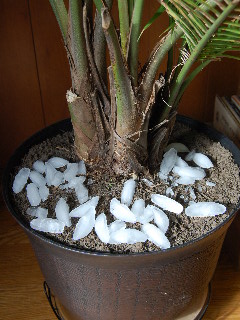
Here’s a handy little tip you may want to try in watering your houseplants.
We tried this out last fall when we moved the big potted palm fern into the house from its summer location outside on the deck.
I first tried watering from the bottom by filling the tray the pot was sitting in, thus hoping the water would be adequately “wicked” up into the potting soil.
But it didn’t seem like this method was working very well as little moisture was being drawn up and only over a period of time.
Next, we watered from the top.
But the water seemed to run through the potting soil and down into the tray too quickly as if it also was not being soaked into the soil for utilization by the plant roots.
Another problem caused by watering from the top was the mess created when the overflow of water from the tray ran out onto the hardwood floor--get the mop!
Sooooooo......Here’s the solution.
We decided one way to water from the top but to allow the moisture to soak SLOWLY into the soil would be to place ice cubes on top of the soil.
This is like placing a soaker hose on the surface of the potting soil of your houseplants. The melting ice cubes allow the water to be applied over a period of time, thus gently and slowly moving moisture down into the soil and around the roots.
How do you know how many ice cubes to use? First, cover the surface of the soil pretty completely and let these melt and soak in. Then add another batch.
Keep doing this several times (it usually takes a couple of hours for the cubes to melt), until you start to see a little bit of water show up in the bottom tray. Don’t worry. Since the water moves down so slowly and has time to soak in as it goes, it shouldn’t overfill your tray.
I’ve heard this is also a good way to water Bonsai container plants to carefully control the amount of moisture going to the plant.
Try this method of slow-soaking your houseplants and see how it works for you!